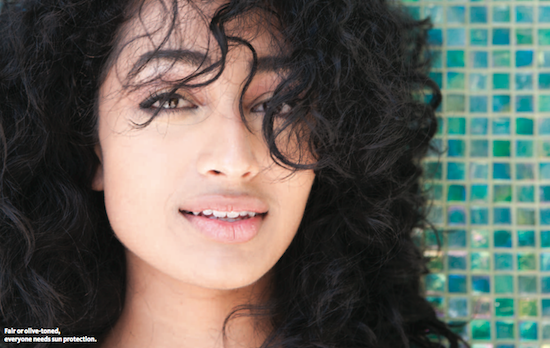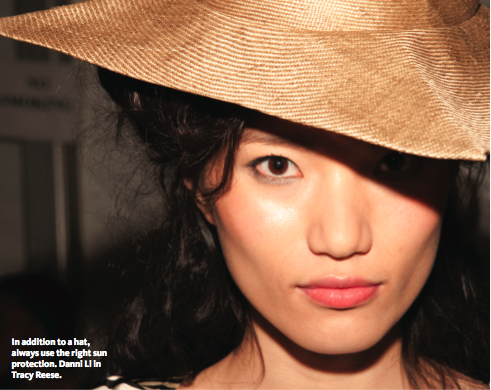ISSUE: Summer 2011
DEPT: Beauty Kit
STORY: Anna M. Park
We all know by now that we have to protect ourselves from the sun. But there is so much confusion out there about SPF, the different types of blockers and how much to apply. So we asked cosmetic dermatologist and author Tess Mauricio, M.D., who is of Filipino, Chinese and Spanish descent, to cut to the basics.
When it comes to sun care, Dr. Tess (as she is known) recommends a multi- pronged approach: a topical sunscreen (whether chemical or physical, powder or lotion), a Heliocare supplement, makeup with sunscreen, and protective clothing (hats, sunglasses, etc.). This is because most people don’t apply enough sunscreen in the first place, she says. So you have to reapply with whatever you can after three hours in direct sunlight. “I think the most important thing to remember is that everyone should apply some kind of sunscreen every day.” Here, Dr. Tess breaks down the basics of sun protection.

Different Types of Sunblock
Chemical Sunscreens: Chemicals that absorb UVA (aging, DNA damage) and UVB (burning) rays.
- Ingredients: Avobenzone, Octinoxate
- Benefits: Protects the deeper layers of skin against the aging effects of UVA rays, and the UVB rays that are responsible for sunburns and tanning. Many of my patients with darker skin tones prefer a chemical sunscreen because it does not leave a residue.
- Limitations: Chemical sunscreens have a tendency to break down and must be reapplied. Many chemical sunscreens are irritating and can cause allergic reactions in some people.
Physical Sunscreens: Think of these like a barrier between the sun and the skin; they actually physically block and then scatter the sun’s rays.
- Ingredients: Titanium Dioxide, Zinc Oxide
- Benefits: Physical sunscreens do not penetrate the skin, are rarely irritating and block the full spectrum of UVA, UVB and visible light.
- Limitations: They can leave a residue behind and are rarely very moisturizing. I generally recommend a physical sunscreen for my patients with sensitive skin (Asian skin is usually sensitive) or for patients who will be spending a long time in the sun, as well as those who undergo certain in-office procedures like chemical peels.

Oral Supplements: There’s a new category in sun protection and it’s one that I recommend for everyone. Heliocare with polypodium leucotomos is an oral dietary supplement in capsule form. This orange capsule helps to protect the skin structure and immune response and provides daily defense against the UV photoaging process. Sounds like a mouthful, but when used in conjunction with a topical sunscreen, Heliocare provides the added protection necessary since no sunscreen, alone, can provide 100 percent UV protection.
SPF Numbers
SPF measures the amount of the time it takes an individual to burn in the sun when not wearing sunscreen versus the time it takes when wearing sunscreen. An SPF 15 product blocks about 94 percent of UVB rays, an SPF 30 blocks 97 percent, and SPF 45 blocks about 98 percent of UVB rays. When you move into SPFs greater than 50, the additional UVB rays that are blocked are minimal, as no sun- screen will protect at 100 percent. This is the reason some say that an SPF over 30 is unnecessary.
That being said, we dermatologists know that most people do not apply sunscreen in adequate amounts or reapply as needed. So we will often encourage our patients to go as high as possible, especially if you have a history of photo- damage and skin cancer. As a general rule, I think most people end up with about 50 percent of the sun protection that the SPF rating actually shows, so if you are using an SPF 50 and applying it as most people do, you are actually getting an SPF of 25.
You’ve heard you need a shot glass worth of sunscreen for the body. Dr. Tess says half a teaspoon should be applied on the face every day.
Reapplication
All the experts say to reapply sunscreen throughout the day. But how to do it on a full face of makeup? “Just pat the sun- screen over your makeup – don’t rub it in – and you should be fine,” says Dr. Tess. You can even use powder sunscreen “if you apply enough, but you probably don’t.” And if you’re going to be in direct sunlight, “take another Heliocare capsule after four hours,” she adds.
Expiration
If your sunscreen is older than three years or past the labeled expiration date, chuck it, says Dr. Tess.
Dr. Tess is the founder of Scripps Ranch Dermatol- ogy & Cosmetic Center in San Diego, Calif.; Dr. Tess Dermatology in La Jolla, Calif.; and is currently expanding offices into China. The former president of the San Diego Society of Dermatologic Surgery graduated from Stanford University School of Medicine and is a summa cum laude graduate of the University of California San Diego. Learn more at TessMD.com.
Read more of the Summer issue here.
Purchase the Summer issue of Audrey Magazine here.









